Rafael Nadal: Farewell to the ‘King of Clay’
With tears in his eyes, Rafael Nadal said goodbye to professional tennis on Tuesday.
In a message to his adoring fans, one of the all-time greatest athletes said he just wanted to be celebrated for something so simple.
“I just want to be remembered as a good person and a kid that followed their dreams and achieved more than what I’ve ever dreamed,” the Spanish great modestly said after playing in his final match.
Despite Nadal and Spain having just been shockingly ousted from the Davis Cup by the Netherlands, the 38-year-old appeared at peace with his decision to walk away from a trophy-laden career while listening to his peers praise him in a tribute video.
“It was such a privilege to play with you but especially against you,” Roger Federer said. “Congratulations on the most incredible career.”
Novak Djokovic added, “Your tenacity, your fighting spirit, the energy that you brought, the power, is something that will be studied and something that will be transferred to many, many generations that are coming up.
“I’ve been very honored and thrilled to be called your rival.”
Serena Williams admitted, “You inspired me to have so many wins – to keep going – to fight – to get better – to improve – to basically play like you.”
The accolades could have continued for hours.
As he walked off the court, the tennis great blew kisses to the crowd and hugged his Spanish teammates before waving goodbye.
Full circle moment
Nadal’s singular career began in 2001, when he turned professional at the age of just 14.
It wasn’t until April 2002, when Nadal was two months shy of his 16th birthday, that he recorded the first ATP Tour win of his career, which fittingly came on his home island of Mallorca.
Nadal then propelled himself from world No. 199 to No. 49 in 2003, winning Challenger titles and matches at Masters 1000 events, as well as recording his first two wins over top 10 opponents – including his current coach, Carlos Moyá.
The following year would be Nadal’s breakthrough on tour and cement his place as a Spanish hero.
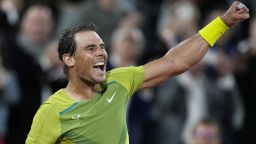 Spain’s Rafael Nadal celebrates winning against France’s Corentin Moutet in three sets, 6-3, 6-1, 6-4, during their second round match at the French Open tennis tournament in Roland Garros stadium in Paris, France, Wednesday, May 25, 2022. (AP Photo/Christophe Ena) Christophe Ena/AP
Spain’s Rafael Nadal celebrates winning against France’s Corentin Moutet in three sets, 6-3, 6-1, 6-4, during their second round match at the French Open tennis tournament in Roland Garros stadium in Paris, France, Wednesday, May 25, 2022. (AP Photo/Christophe Ena) Christophe Ena/AP
Related article This world-class athlete talks like Aristotle and acts like Confucius. We can all learn from him
He won the first ATP singles title of his career at the Pokrom Open and then, at just 18 years of age, beat world No. 2 Andy Roddick in the final of the Davis Cup on home soil to help Spain win the title for only the second time in history.
It is fitting that Nadal bade farewell to tennis on the stage that helped make him in Spain.
That year, 2003, there was also the small matter of a first meeting with Federer, a straight sets win for Nadal at the Miami Open that surely nobody predicted would be the beginning of arguably tennis’ greatest rivalry.
“All that buzz I’d been hearing about you — about this amazing young player from Mallorca, a generational talent, probably going to win a major someday — it wasn’t just hype,” Federer wrote of that match in his farewell message to Nadal.
But 2004 was the year Nadal truly shot to stardom and became a household name.
He won 24 straight matches during the clay court season, breaking Andre Agassi’s Open Era record for most consecutive victories by a teenager, culminating in his first French Open title in his tournament debut.
He may not quite have been the King of Clay just yet, but his game on the red stuff was already looking princely.
 Rafael Nadal serves during a French Open match in 2018. Christophe Simon/AFP/Getty Images
Rafael Nadal serves during a French Open match in 2018. Christophe Simon/AFP/Getty Images  A young Nadal poses with his trophies at a tennis club in Mallorca, Spain. He was coached by his uncle Toni, who persuaded him to play left-handed despite being naturally right-handed. Frank Coppi/Popperfoto/Getty Images
A young Nadal poses with his trophies at a tennis club in Mallorca, Spain. He was coached by his uncle Toni, who persuaded him to play left-handed despite being naturally right-handed. Frank Coppi/Popperfoto/Getty Images  Nadal, 13, competes at a junior tournament in France in 2000. Manuel Blondeau/AOP.Press/Corbis/Getty Images
Nadal, 13, competes at a junior tournament in France in 2000. Manuel Blondeau/AOP.Press/Corbis/Getty Images 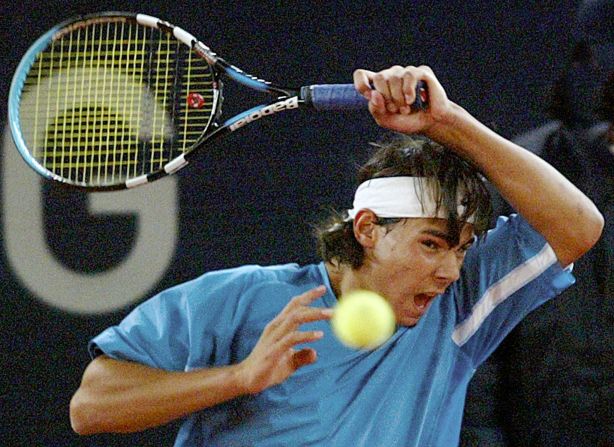 Nadal plays at the Hamburg Masters in Germany in 2003. Nadal’s powerful forehand, hit with extreme top spin, would become his signature shot. Friedemann Vogel/Bongarts/Getty Images
Nadal plays at the Hamburg Masters in Germany in 2003. Nadal’s powerful forehand, hit with extreme top spin, would become his signature shot. Friedemann Vogel/Bongarts/Getty Images  Nadal rides a dolphin at the Miami Seaquarium in March 2004. Al Bello/Getty Images
Nadal rides a dolphin at the Miami Seaquarium in March 2004. Al Bello/Getty Images  Nadal, second from right, poses with other members of Team Spain after they won the Davis Cup in December 2004. With Nadal, from left, are Juan Carlos Ferrero, Tommy Robredo, Jordi Arrese and Carlos Moya. Clive Brunskill/Getty Images
Nadal, second from right, poses with other members of Team Spain after they won the Davis Cup in December 2004. With Nadal, from left, are Juan Carlos Ferrero, Tommy Robredo, Jordi Arrese and Carlos Moya. Clive Brunskill/Getty Images  Nadal signs autographs at the Australian Open in January 2005. Nick Laham/Getty Images
Nadal signs autographs at the Australian Open in January 2005. Nick Laham/Getty Images 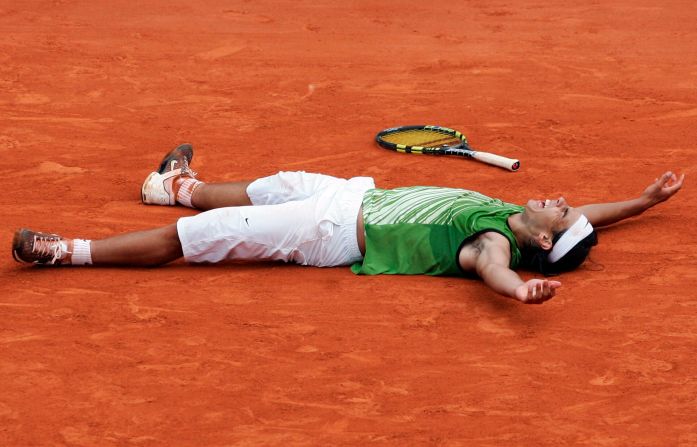 Nadal reacts after he won the French Open final in June 2005. He defeated Mariano Puerta to claim his first grand slam title. Christophe Ena/AP
Nadal reacts after he won the French Open final in June 2005. He defeated Mariano Puerta to claim his first grand slam title. Christophe Ena/AP  Nadal, top left, plays Roger Federer during a special “Battle of the Surfaces” tennis match in Palma, Spain, in May 2007. Half of the court was on clay, Nadal’s specialty, and half was on grass, Federer’s specialty. Nadal won the three-set exhibition in front of his home crowd. Dani Cardona/Reuters
Nadal, top left, plays Roger Federer during a special “Battle of the Surfaces” tennis match in Palma, Spain, in May 2007. Half of the court was on clay, Nadal’s specialty, and half was on grass, Federer’s specialty. Nadal won the three-set exhibition in front of his home crowd. Dani Cardona/Reuters 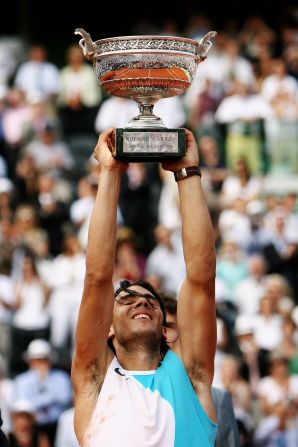 Nadal lifts the Philippe Chatrier Trophy after defeating Federer to win the French Open in June 2007. It was his third straight French Open title. Clive Brunskill/Getty Images
Nadal lifts the Philippe Chatrier Trophy after defeating Federer to win the French Open in June 2007. It was his third straight French Open title. Clive Brunskill/Getty Images  Nadal and Federer leave the court together after the Wimbledon final in July 2007. Federer had just won for the fifth straight year. Anja Niedringhaus/AP
Nadal and Federer leave the court together after the Wimbledon final in July 2007. Federer had just won for the fifth straight year. Anja Niedringhaus/AP 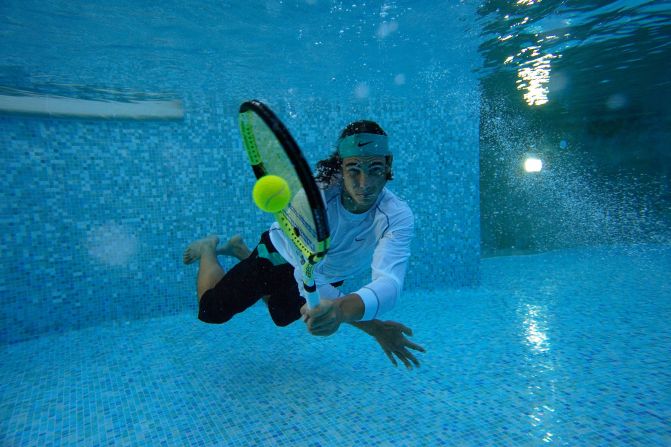 Nadal poses for an underwater portrait in Monaco in 2007. Clive Brunskill/Getty Images
Nadal poses for an underwater portrait in Monaco in 2007. Clive Brunskill/Getty Images  Nadal and Federer play an epic Wimbledon final in July 2008. Nadal won a five-set thriller that lasted nearly five hours, ending Federer’s reign in what some called the greatest tennis match they had seen. Simon Bruty/Sports Illustrated/Getty Images
Nadal and Federer play an epic Wimbledon final in July 2008. Nadal won a five-set thriller that lasted nearly five hours, ending Federer’s reign in what some called the greatest tennis match they had seen. Simon Bruty/Sports Illustrated/Getty Images  Nadal celebrates after defeating Federer in the 2008 Wimbledon final. It was Nadal’s first Wimbledon title. Alessia Pierdomenico/Pool/Getty Images
Nadal celebrates after defeating Federer in the 2008 Wimbledon final. It was Nadal’s first Wimbledon title. Alessia Pierdomenico/Pool/Getty Images  Nadal, center, listens to the Spanish national anthem after winning gold at the Beijing Olympics in August 2008. He defeated Chile’s Fernando Gonzalez in the final. Serbia’s Novak Djokovic, seen on the right, won the bronze. Behrouz Mehri/AFP/Getty Images
Nadal, center, listens to the Spanish national anthem after winning gold at the Beijing Olympics in August 2008. He defeated Chile’s Fernando Gonzalez in the final. Serbia’s Novak Djokovic, seen on the right, won the bronze. Behrouz Mehri/AFP/Getty Images 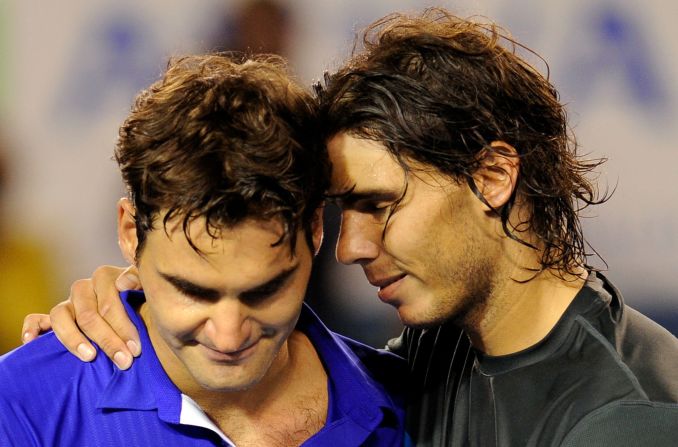 Nadal hugs Federer after defeating him in the Australian Open final in February 2009. The two rivals played each other 40 times. Nine of those matches were grand slam finals. Andrew Brownbill/AP
Nadal hugs Federer after defeating him in the Australian Open final in February 2009. The two rivals played each other 40 times. Nine of those matches were grand slam finals. Andrew Brownbill/AP  Nadal and Federer are seated for a group photo with other stars at the ATP World Tour Finals in November 2009. Standing, from left, are Juan Martin del Potro, Djokovic, Andy Murray, Fernando Verdasco, Nikolay Davydenko and Robin Soderling. Julian Finney/Getty Images
Nadal and Federer are seated for a group photo with other stars at the ATP World Tour Finals in November 2009. Standing, from left, are Juan Martin del Potro, Djokovic, Andy Murray, Fernando Verdasco, Nikolay Davydenko and Robin Soderling. Julian Finney/Getty Images 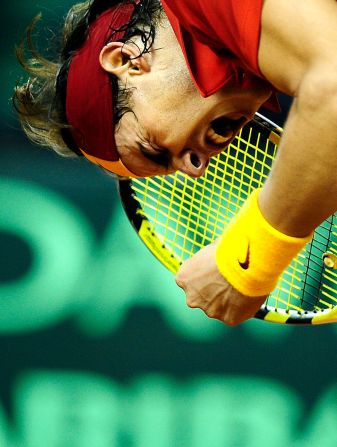 Nadal reacts after winning a Davis Cup match in December 2009. David Ramos/AP
Nadal reacts after winning a Davis Cup match in December 2009. David Ramos/AP  Nadal celebrates in the locker room with Spain’s football team after it won the FIFA World Cup in July 2010. At right is Spanish goalkeeper Iker Casillas. Alex Livesey/FIFA/Getty Images
Nadal celebrates in the locker room with Spain’s football team after it won the FIFA World Cup in July 2010. At right is Spanish goalkeeper Iker Casillas. Alex Livesey/FIFA/Getty Images 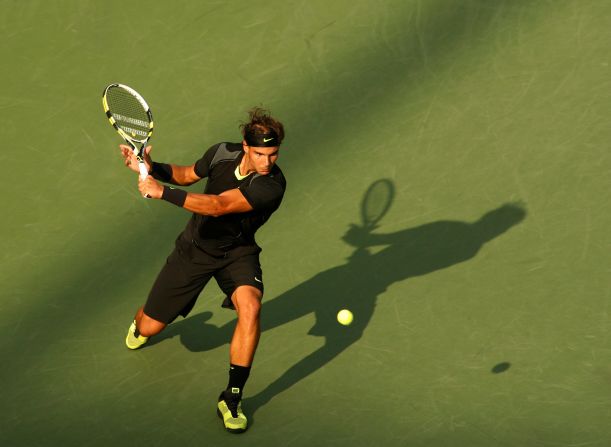 Nadal hits a shot in the US Open final in September 2010. Nadal defeated Djokovic to win his first US Open and complete a career grand slam. David Saffran/Icon Sports Wire/Corbis/Getty Images
Nadal hits a shot in the US Open final in September 2010. Nadal defeated Djokovic to win his first US Open and complete a career grand slam. David Saffran/Icon Sports Wire/Corbis/Getty Images  Nadal raises his arms in victory after winning the 2010 US Open final. Only seven other male players in history have won all four major championships. Clive Brunskill/Getty Images
Nadal raises his arms in victory after winning the 2010 US Open final. Only seven other male players in history have won all four major championships. Clive Brunskill/Getty Images  Nadal and Federer play on a floating court to promote the city of Doha, Qatar, ahead of the Qatar Open in 2011. Ho New/Qatar Tennis Federation/Reuters
Nadal and Federer play on a floating court to promote the city of Doha, Qatar, ahead of the Qatar Open in 2011. Ho New/Qatar Tennis Federation/Reuters  Nadal’s French Open dominance is evident by the inscriptions on the trophy in June 2013. He had just won his fourth straight French and the eighth of his career. Christophe Ena/AP
Nadal’s French Open dominance is evident by the inscriptions on the trophy in June 2013. He had just won his fourth straight French and the eighth of his career. Christophe Ena/AP  Nadal, right, and David Ferrer rest between sets at the Paris Masters in November 2013. Charles Platiau/Reuters
Nadal, right, and David Ferrer rest between sets at the Paris Masters in November 2013. Charles Platiau/Reuters  Nadal arrives for a match at the ATP World Tour Finals in November 2013. Suzanne Plunkett/Reuters
Nadal arrives for a match at the ATP World Tour Finals in November 2013. Suzanne Plunkett/Reuters  Nadal, back center, attends a ceremony in Palma, Spain, where he was named a “Favorite Son of Mallorca” in 2014. Jaime Reina/AFP/Getty Images
Nadal, back center, attends a ceremony in Palma, Spain, where he was named a “Favorite Son of Mallorca” in 2014. Jaime Reina/AFP/Getty Images  Nadal delivers a serve during an Australian Open match in 2015. Hannah Peters/Getty Images
Nadal delivers a serve during an Australian Open match in 2015. Hannah Peters/Getty Images  Nadal carries Spain’s flag during the Olympics opening ceremony in Rio de Janeiro in 2016. Franck Fife/AFP/Getty Images
Nadal carries Spain’s flag during the Olympics opening ceremony in Rio de Janeiro in 2016. Franck Fife/AFP/Getty Images  Nadal celebrates after defeating Stan Wawrinka to win the 2017 French Open. Julian Finney/Getty Images
Nadal celebrates after defeating Stan Wawrinka to win the 2017 French Open. Julian Finney/Getty Images  Nadal ties his headband before a Wimbledon semifinal match in 2018. Daniel Leal/Pool/AFP/Getty Images
Nadal ties his headband before a Wimbledon semifinal match in 2018. Daniel Leal/Pool/AFP/Getty Images  An advertisement is seen behind Nadal during an Australian Open match in January 2019. Aly Song/Reuters
An advertisement is seen behind Nadal during an Australian Open match in January 2019. Aly Song/Reuters 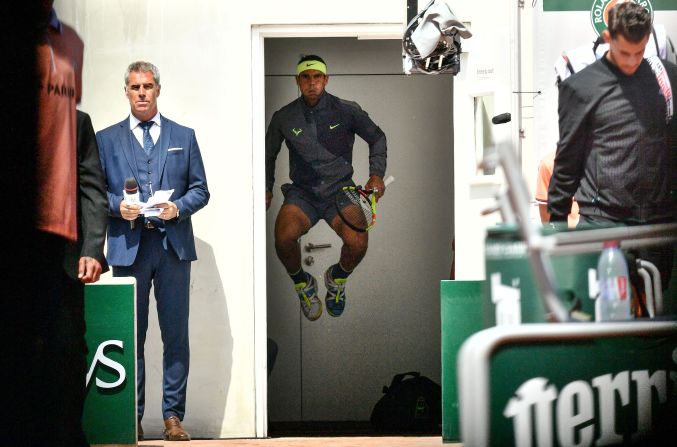 Nadal warms up before entering the court for the French Open final in June 2019. Philippe Lopez/AFP/Getty Images
Nadal warms up before entering the court for the French Open final in June 2019. Philippe Lopez/AFP/Getty Images  Nadal plays a forehand during a Wimbledon semifinal in July 2019. Adrian Dennis/Pool/Getty Images
Nadal plays a forehand during a Wimbledon semifinal in July 2019. Adrian Dennis/Pool/Getty Images  Nadal reacts after defeating Daniil Medvedev to win the US Open in September 2019. Nadal played in 30 grand slam finals and won 22 of them. Eduardo Munoz Alvarez/AP
Nadal reacts after defeating Daniil Medvedev to win the US Open in September 2019. Nadal played in 30 grand slam finals and won 22 of them. Eduardo Munoz Alvarez/AP  Nadal poses with his wife, Maria Francisca Perello, after they were married in Mallorca in October 2019. Fundacion Rafa Nadal/Getty Images
Nadal poses with his wife, Maria Francisca Perello, after they were married in Mallorca in October 2019. Fundacion Rafa Nadal/Getty Images 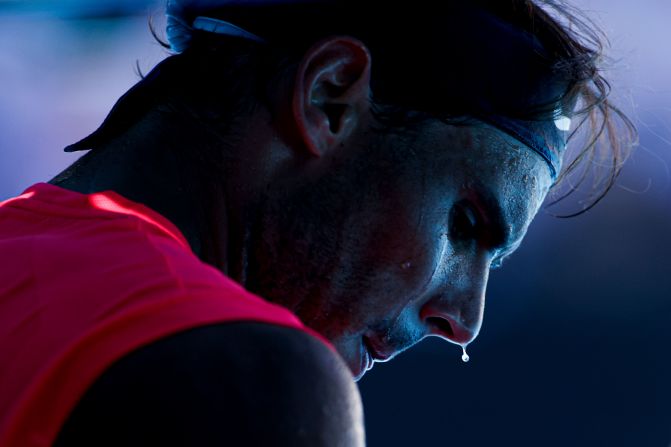 Nadal rests between games at the Australian Open in 2020. Fred Lee/Getty Images
Nadal rests between games at the Australian Open in 2020. Fred Lee/Getty Images  People in Paris watch Nadal and Alexander Zverev play a French Open semifinal in June 2022. Thomas Samson/AFP/Getty Images
People in Paris watch Nadal and Alexander Zverev play a French Open semifinal in June 2022. Thomas Samson/AFP/Getty Images 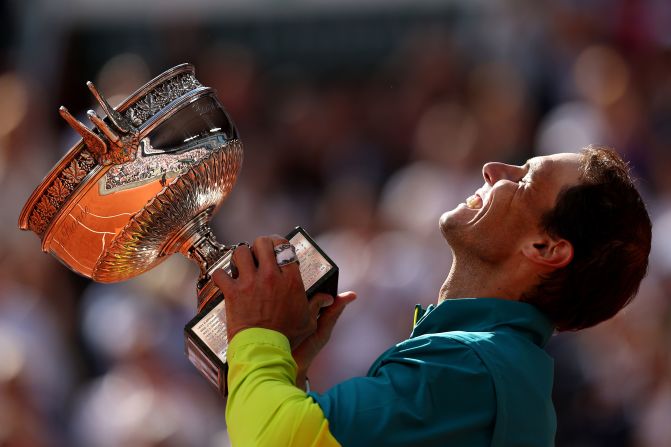 Nadal celebrates after he defeated Casper Ruud to win the 2022 French Open. It was his 22nd grand slam title and the last of his career. Clive Brunskill/Getty Images
Nadal celebrates after he defeated Casper Ruud to win the 2022 French Open. It was his 22nd grand slam title and the last of his career. Clive Brunskill/Getty Images  Nadal receives the Camino Real Award from Spain’s King Felipe in September 2022. Jesus Hellin/Europa Press/Getty Images
Nadal receives the Camino Real Award from Spain’s King Felipe in September 2022. Jesus Hellin/Europa Press/Getty Images  Nadal teams up with Federer for a doubles match at the Laver Cup in London in September 2022. It was the final match of Federer’s career. Julian Finney/Getty Images for Laver Cup
Nadal teams up with Federer for a doubles match at the Laver Cup in London in September 2022. It was the final match of Federer’s career. Julian Finney/Getty Images for Laver Cup  Federer and Nadal tear up after their Laver Cup match. Ella Ling/Shutterstock
Federer and Nadal tear up after their Laver Cup match. Ella Ling/Shutterstock 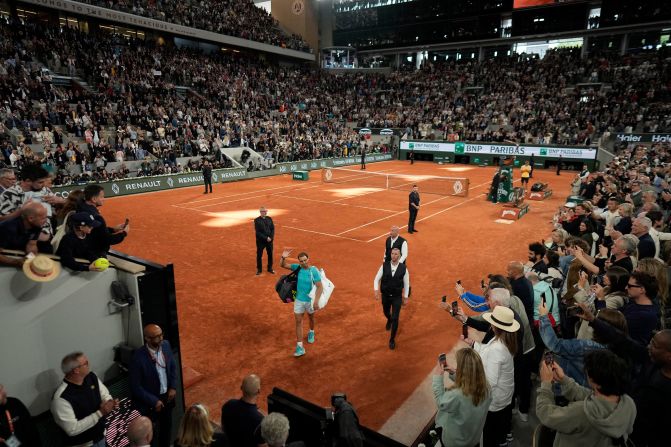 Nadal waves goodbye to fans and receives a thunderous ovation after he lost to Zverev in the first round of the French Open in May 2024. His all-time record at the French Open was 112-4. “I don’t know if it’s going to be last time I’m going to be here in front of you,” he said in an on-court interview after the match. “I am not 100% sure, but if it is the last time, I enjoyed it.” Thibault Camus/AP
Nadal waves goodbye to fans and receives a thunderous ovation after he lost to Zverev in the first round of the French Open in May 2024. His all-time record at the French Open was 112-4. “I don’t know if it’s going to be last time I’m going to be here in front of you,” he said in an on-court interview after the match. “I am not 100% sure, but if it is the last time, I enjoyed it.” Thibault Camus/AP  Nadal carries the Olympic flame on a boat during the opening ceremony of the Paris Olympics in July 2024. With him are a few famous former Olympians: from left, Carl Lewis, Nadia Comăneci and Serena Williams. Alex Pantling/Getty Images
Nadal carries the Olympic flame on a boat during the opening ceremony of the Paris Olympics in July 2024. With him are a few famous former Olympians: from left, Carl Lewis, Nadia Comăneci and Serena Williams. Alex Pantling/Getty Images  Nadal and Spain’s Carlos Alcaraz react while playing a men’s doubles match at the Paris Olympics in July 2024. Patricia de Melo Moreira/AFP/Getty Images
Nadal and Spain’s Carlos Alcaraz react while playing a men’s doubles match at the Paris Olympics in July 2024. Patricia de Melo Moreira/AFP/Getty Images  Nadal waves to the crowd during a tribute after playing his last match as a professional tennis player in the Davis Cup quarterfinals in Málaga, Spain, in November 2024. Manu Fernandez/AP In pictures: Tennis legend Rafael Nadal Prev Next
Nadal waves to the crowd during a tribute after playing his last match as a professional tennis player in the Davis Cup quarterfinals in Málaga, Spain, in November 2024. Manu Fernandez/AP In pictures: Tennis legend Rafael Nadal Prev Next
Nadal became the first male teenager to win a grand slam since Pete Sampras won the 1990 US Open and climbed to a career high No. 3 in the world.
It was the first of four straight French Open titles, before he was stunned by Robin Söderling in the fourth round in 2009 for his first ever defeat at Roland Garros.
That loss would be the first of just three that Nadal suffered at the French Open, though he had to retire injured ahead of his third-round match in 2016, giving him a 112-3 record on the Parisian clay, a win rate of 97.39%.
“On clay, it felt like I was stepping into your backyard, and you made me work harder than I ever thought I could just to hold my ground,” Federer wrote.
“You made me reimagine my game – even going so far as to change the size of my racquet head, hoping for any edge.”
Greatest match ever?
Nadal’s relentless brilliance on clay redefined what it means to dominate a surface.
The Spaniard finished his career with 14 French Open titles, two Australian Opens, two Wimbledon titles and four US Opens for a total of 22 grand slams, second all-time behind only Djokovic.
“I’ve been able to compete against him a couple of times, get wins over him which, again, you tell the little kid that’s watching him on TV winning 14 Roland Garros in a row, it’s pretty special,” world No. 9 Alex de Minaur told CNN Sport.
“All those experiences of sharing the court with him is something I’ll take with me for a very long time and I’ll pass it on to generations to come.”
Though grass was considered Nadal’s weakest of the three grand slam surfaces, it was on Wimbledon’s Centre Court that he enjoyed arguably his most iconic moment.
In the fading late-evening summer light, Nadal finally toppled Federer in 2008 and ended the Swiss’ five-year winning run at Wimbledon in a match that spanned almost seven hours from start to finish due to rain delays.
 Nadal celebrates after beating Roger Federer in the Wimbledon final in 2008. Alessia Pierdomenico/Pool/Getty Images
Nadal celebrates after beating Roger Federer in the Wimbledon final in 2008. Alessia Pierdomenico/Pool/Getty Images
That was the last year Wimbledon was played without a roof on Centre Court, putting an end to matches being interrupted by dramatic hours-long delays.
Federer beat Nadal in the final in 2006 and 2007, but the Spaniard had demolished Federer 6-1, 6-3, 6-0 in the French Open final a month earlier.
In practical darkness on Centre Court, Nadal eventually won 9-7 in the fifth set. It is considered by many to be the greatest tennis match of all time.
“I didn’t watch a lot of tennis growing up but even I was watching Rafa,” ATP Finals runner-up Taylor Fritz told CNN Sport recently.
“I remember the Wimbledon final with him and Fed and it’s insane that I was a little kid – not like a teenager – I was a little kid watching him play and then we grew up and have gotten the chance to play against him.
“That’s something that’s so special and there’s only a couple of players that are like that. It’s really kind of crazy when you get the chance to play against him.”
In August 2008, Nadal finally became world No. 1 for the first time, a position he would hold for a total of 209 weeks throughout his career.
Among his many career achievements, Nadal became just the second man to achieve the career singles ‘Golden Slam’ in 2010 – winning all four grand slams and Olympic gold – and helped Spain win four Davis Cup titles.
 Nadal’s career was intertwined along with a healthy rivalry with Federer. Andrew Brownbill/AP
Nadal’s career was intertwined along with a healthy rivalry with Federer. Andrew Brownbill/AP
He also won Olympic doubles gold in 2016 and amassed a total of 92 ATP titles.
Nadal developed a reputation as one of the most tenacious players tennis has seen, chasing down every ball with fierce determination, even those that many other players would have given up as lost causes.
But the question is frequently asked as to whether Nadal’s aggressive style of play that made him so successful has in some way contributed to his injury problems.
Injuries
With the number of injuries Nadal has suffered over the course of his career, it’s easy to ask: ‘What if?’
What if he hadn’t missed 11 grand slams due to various ailments? What if his body hadn’t failed him numerous times throughout his career?
How many grand slams would Nadal have now? How many more records would he have broken?
But Nadal never let the injuries define his career; though, of course, they played a big part. Instead, his career has largely been defined by his response to them: his tenacity, his will to win, and his unrelenting desire to come back time and again – and return to the top.
In the end, however, it proved to be one injury too many for his 38-year-old body to recover from – though his mind was evidently still as willing as ever, with Nadal often expressing his desire to return again next year.
But the injuries just mean the numbers and records Nadal has accumulated over his career are all the more remarkable.
Source: edition.cnn.com
